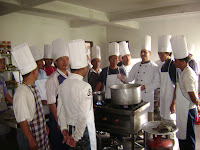The food of Nepal is as diverse as the country itself. The Nepalese recipes are quick to cook and good to eat. Nepalese food is famous for its nutrition level and tempting taste. Whilst Nepalese cuisine is somewhat basic, it certainly does not lack in flavor, making extensive use of spices and flavorings such as ginger, garlic, coriander, pepper, cumin, chilies, cilantro, mustard oil, ghee and occasionally yak butter. Come let us savour some of the famous dishes of Nepal.
Eating HabitsMain MealIn most part of country, especially rice-growing areas, Dal Bhat (pulses and rice) is the staple food of Nepalese, that is eaten twice a day.
SnackingSnacks such as bread, chura (beaten rice), roti (flat bread), curried vegetables, milked tea and other snacks are also generally eaten in between the two big meals.
Famous Nepalese CuisineGundrook- Dheedo Equally popular among Nepali people and foreign tourists, Gundrook-Dheedo is a sugar-free dish made of wheat, maize and dried green vegetable. The food is high on nutrition level and satisfies the taste buds as well.
Alu TamaAloo Tama (Alu Tama) simply means 'Potato Bamboo Shoots'. It is a unique and classic Nepali curry flavor dish. It is unique in the sense that it is unlike any other Indian or South Asian curry since they rarely use bamboo shoots. Similarly, unlike other East Asian cuisine such as Chinese that uses Bamboo shoots but do not use curry spices.
Vegetable Pulao(Fried Nepali Rice)Vegetable Pulao is one of the popular ways rice is served during the parties and events in the Nepalese household. It has flavor of turmeric and cumin to it. The rice is particularly famous among tourists who prefer eating it with curd and Manchurian.
MasuMasu is spiced or curried meat (usually chicken, mutton, buffalo or pork) with gravy. Served with rice, it is a main course dish, very popular in Nepal.
Vegetable Thukpa(Egg Noodles)This is a seasonal dish. Tibetan Vegetable Thukpa is one of the main food. During Tibetan new year celebration 'Losar'the dish is a part of celebration and tradition for the Nepalese.
Chatamari Regarded as Newari pizza, Chatamari is a flat bread made from rice flour with or without toppings (meat, vegetables, eggs, sugar). It is highly savoured by the tourists who consider it as a good and healthy substitute to pizza.
DrinksTongbaA special Limbu culture drink, Tongba is homemade wine. Fermented millet seeds are put in a wooden or plastic mug which is filled with hot water. One sips through a bamboo straw as more hot water is added which makes Tongba go down easily with greater impact and taste. Many consume this drink during winter season, and is also a favorite drink among the tourists.
RakshiRakshi is a millet-based distilled alcoholic drink It is traditionally an important requirement at a lot of religious rituals and social events, perhaps because it is not only an alcoholic drink but also because of its antiseptic qualities. It is a strong drink, and is often brewed at home.Apart from its traditional food the country offers a wide range of Chinese and Japanese fast foods like momos and macaroni. There are many food outlets in the city which provide the traveler with excellent cooking. The food in Nepal is delicious and is available at a very reasonable price to the tourist so that they could fully enjoy the mouth watering traditional recipes of the region.








 Ingredients
Ingredients


 Vegetable and Egg Fried Rice
Vegetable and Egg Fried Rice
 Thai fried rice (Thai: ข้าวผัด IPA: Khao Pad or Khao Phad) is a variety of Fried rice that is prepared in the style of central Thai cuisine. In Thai khao is rice) + pad (of or relating to being stir-fried). One of the ways the dish differs from Chinese fried rice is that it is prepared with Thai Jasmine rice instead of regular long-grain rice. It normally contains a meat (chicken, pork, beef, shrimp, and crab are all common), egg, onions, and tomatoes. Green onions, coriander, and fried garlic are then mixed in. However, each individual place varies as it is a ubiquitous dish. Then seasonings are poured in, including soy sauce, sugar, salt, possibly some chili sauce, and the ubiquitous nam pla (fish sauce). These are stirred in, and then the dish is plated and served with accompaniments like cucumber slices, tomato slices, lime and sprigs of green onion.
Thai fried rice (Thai: ข้าวผัด IPA: Khao Pad or Khao Phad) is a variety of Fried rice that is prepared in the style of central Thai cuisine. In Thai khao is rice) + pad (of or relating to being stir-fried). One of the ways the dish differs from Chinese fried rice is that it is prepared with Thai Jasmine rice instead of regular long-grain rice. It normally contains a meat (chicken, pork, beef, shrimp, and crab are all common), egg, onions, and tomatoes. Green onions, coriander, and fried garlic are then mixed in. However, each individual place varies as it is a ubiquitous dish. Then seasonings are poured in, including soy sauce, sugar, salt, possibly some chili sauce, and the ubiquitous nam pla (fish sauce). These are stirred in, and then the dish is plated and served with accompaniments like cucumber slices, tomato slices, lime and sprigs of green onion.